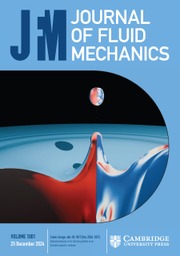Crossref Citations
This article has been cited by the following publications. This list is generated based on data provided by
Crossref.
Yuster, T.
and
Hackborn, W. W.
1997.
On invariant manifolds attached to oscillating boundaries in Stokes flows.
Chaos: An Interdisciplinary Journal of Nonlinear Science,
Vol. 7,
Issue. 4,
p.
769.
Danilov, S. D.
Dovzhenko, V. A.
and
Yakushkin, I. G.
2000.
Transport of a passive scalar and Lagrangian chaos in a Hamiltonian hydrodynamic system.
Journal of Experimental and Theoretical Physics,
Vol. 91,
Issue. 2,
p.
423.
Hajjam, M.
2001.
Comportement des lignes de decollement en regime de stokes dans un espace annulaire.
Mechanics Research Communications,
Vol. 28,
Issue. 1,
p.
113.
Qian, Shizhi
Zhu, Jianzhong
and
Bau, Haim H.
2002.
A stirrer for magnetohydrodynamically controlled minute fluidic networks.
Physics of Fluids,
Vol. 14,
Issue. 10,
p.
3584.
Price, T.J.
Mullin, T.
and
Kobine, J.J.
2003.
Numerical and experimental characterization of a family of two–roll–mill flows.
Proceedings of the Royal Society of London. Series A: Mathematical, Physical and Engineering Sciences,
Vol. 459,
Issue. 2029,
p.
117.
Peacock, Thomas
Coral, Raul
and
Haller, George
2005.
Experimental Validation of the Kinematic Theory of Unsteady Separation.
Ulucakli, M. Erol
2005.
Chaotic Mixing of Highly Viscous Liquids With Rectangular or Elliptical Rotors.
p.
559.
Jacobs, Gustaaf
Surana, Amit
Peacock, Tom
and
Haller, George
2007.
Identification of Flow Separation in Three and Four Dimensions.
WELDON, M.
PEACOCK, T.
JACOBS, G. B.
HELU, M.
and
HALLER, G.
2008.
Experimental and numerical investigation of the kinematic theory of unsteady separation.
Journal of Fluid Mechanics,
Vol. 611,
Issue. ,
p.
1.
Subramanian, Natarajan
Kellogg, Louise H.
and
Turcotte, Donald L.
2009.
Statistics of Advective Stretching in Three-dimensional Incompressible Flows.
Journal of Statistical Physics,
Vol. 136,
Issue. 5,
p.
926.
Oteski, L.
Duguet, Y.
and
Pastur, L. R.
2014.
Lagrangian chaos in confined two-dimensional oscillatory convection.
Journal of Fluid Mechanics,
Vol. 759,
Issue. ,
p.
489.
Miron, Philippe
and
Vétel, Jérôme
2015.
Towards the detection of moving separation in unsteady flows.
Journal of Fluid Mechanics,
Vol. 779,
Issue. ,
p.
819.
Baskan, O.
Speetjens, M. F. M.
Metcalfe, G.
and
Clercx, H. J. H
2015.
Direct experimental visualization of the global Hamiltonian progression of two-dimensional Lagrangian flow topologies from integrable to chaotic state.
Chaos: An Interdisciplinary Journal of Nonlinear Science,
Vol. 25,
Issue. 10,
Lamarche-Gagnon, Marc-Étienne
and
Vétel, Jérôme
2018.
Experimental investigation of unsteady separation in the rotor-oscillator flow.
Journal of Fluid Mechanics,
Vol. 844,
Issue. ,
p.
546.
Filippi, Margaux
Budišić, Marko
Allshouse, Michael R.
Atis, Séverine
Thiffeault, Jean-Luc
and
Peacock, Thomas
2020.
Using braids to quantify interface growth and coherence in a rotor-oscillator flow.
Physical Review Fluids,
Vol. 5,
Issue. 5,
Atis, Séverine
Leclair, Matthieu
Sapsis, Themistoklis P.
and
Peacock, Thomas
2022.
Anisotropic particles focusing effect in complex flows.
Physical Review Fluids,
Vol. 7,
Issue. 8,


